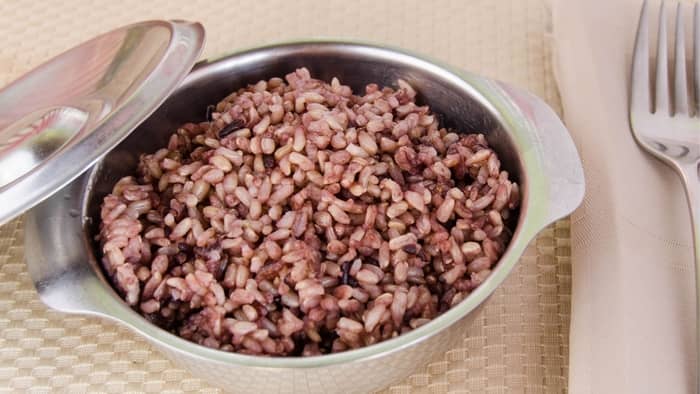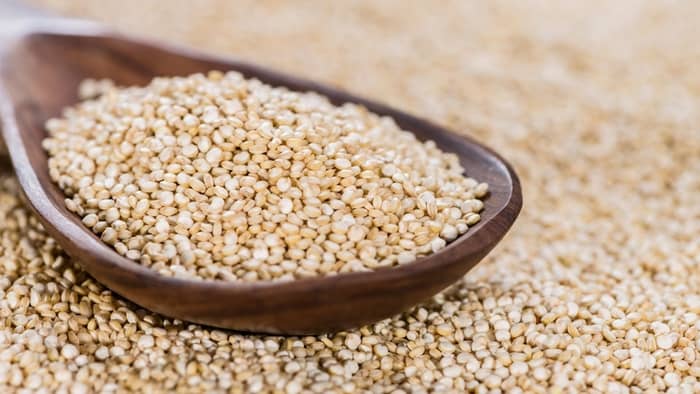Last Updated on April 20, 2022
Today, we’re going to be answering the question: does farro have gluten? And taking a look at the best gluten free grains to include in your diet if you’re gluten-intolerant or have celiac disease. You may not have even heard of farro – which makes it tricky to navigate, as to how can you be sure whether it contains gluten if you’re unsure what it is. That’s where I’m here to help! Let’s first take a look at what farro is, and then we can determine whether it contains gluten.
What Is Farro?
Farro actually refers to a few different varieties of the cereal grain, wheat. When farro is listed as an ingredient, it can mean any of the following:
- spelt
- emmer (an ancient grain)
- einkorn (an ancient grain)
Farro isn’t the same wheat that we’re used to seeing every day in foods such as bread and cakes. Farro is a much heavier flour and darker in the color than modern wheat that we’re familiar with.
Learn more about Bulgur Gluten-Free Substitutes
How To Use Farro
Farro is most commonly used in Italy and southern Europe in the following ways:
- salads
- soups
- vegetable dishes
It’s seen as nutritious and a great addition to your diet.
Does Farro Have Gluten?
Unfortunately, as you can probably tell from the description of farro – it is not gluten-free, and should not be consumed when following a gluten-free lifestyle. However, it’s tricky to navigate as farro is not usually identified as wheat on ingredients labels, so it may be harder to avoid than the more modern cereal grains.
Gluten Free Grains Farro Alternatives
There are gluten-free alternatives to almost everything nowadays – and farro is no different! Let’s take a look at the best gluten-free substitutes for farro.
Sorghum
Sorghum is an ancient cereal grain – however, this grain is 100% gluten-free. It belongs to the grass family and comes in a range of colors, including white, yellow, red, brown, black, and purple. It’s round-shaped and relatively small. Sorghum is most commonly made into flour and is the perfect gluten-free flour to use in most recipes.
The nutritional value for a quarter cup of sorghum is:
- Calories: 163
- Protein: 5g
- Fat: 2g
- Carbohydrates: 36g
- Fiber: 3g
Brown Rice
Brown rice is one of the easier alternatives to obtain. Whether you’re using fresh brown rice or brown rice flour, it’s a good addition to your diet. Brown rice is whole grain rice with the hull of the rice removed. Did you know that brown rice and white rice are the same, except brown rice keeps the bran and germ layers on (which makes it brown), whereas white rice does not.
The nutritional value of a cup of brown rice is:
- Calories: 216
- Protein: 5g
- Fat: 1.8g
- Carbohydrates: 45g
- Fiber: 3.5g

Learn more about: Does Jasmine Rice Have Gluten?
Oat Groats
Oat groats are naturally gluten-free. However, it’s worth noting that you should only buy oats that carry a gluten-free label. This is because oats are often milled with cereal containing grains such as barley and wheat – and therefore would make the oats not gluten-free.
Oat groats have had very little processing, in comparison to other oats and they contain much more fiber, making them a nutritious addition to your diet.
The nutritional value for a quarter cup of oats groats is:
- Calories: 160
- Protein: 7g
- Fat: 3g
- Carbohydrates: 28g
- Fiber: 4g
Amaranth
Amaranth is most commonly known as a “pseudocereal”. This is a name given to a grain that is not a true cereal but is used for its starchy seeds. And as they’re not a traditional cereal grain – they are 100% gluten-free. Amaranth is full of protein, fiber, and other nutritious goodness. Amaranth is a relatively popular ingredient when it comes to gluten-free foods, especially baked goods.
The nutritional value for half a cup of amaranth is:
- Calories: 125
- Protein: 4.7g
- Fat: 1.9g
- Carbohydrates: 23g
- Fiber: 2.6g
Quinoa
Quinoa is definitely the healthiest option we’ve looked at today. It’s packed full of vitamins and dietary minerals, as well as protein and fiber. Did you know that quinoa is in fact part of the amaranth family? It’s typically grown for its edible seeds.
The nutritional value for one cup of quinoa is:
- Calories: 222
- Protein: 8g
- Fat: 6g
- Carbohydrates: 39g
- Fiber: 5g
Quinoa is known as a superfood. This is because it’s such a fantastic grain to add to your diet because of its many nutritional qualities.

Read more about: Is Spelt Bread Gluten-Free? (GF Substitutes)
Conclusion
I hope this article has helped to answer the question: does farro have gluten? And helped you to discover alternatives to farro for your diet. While farro does contain less gluten than modern wheat, you should not be adding it to your diet. To find out more about the gluten-free grains above and buy them yourself, my go-to place is nuts.com.
Do you know of any other gluten-free grains that are a good substitute for farro that didn’t make the list? If so, please feel free to let me know in the comments below. Sharing is caring!
FAQs
What is a Gluten-Free Substitute for Farro?
There are many gluten free substitutes for farro that you can use to replace it in a recipe, or simply add to your diet to make it more balanced. Some of the most popular options include sorghum, brown rice, oat groats, amaranth and quinoa. We'll be taking a closer look at each of those in this post.
How Much Gluten is in Farro?
It is thought that there is less gluten in farro, than that of modern day cereal grains. However, just because the amount of gluten is lower, we highly recommend that you do not add farro to your diet. Any amount of gluten can be damaging, no matter how small the amount may be.
Over the years, cross breeding wheat has become far more prevalent, which has made wheat contain far more gluten than it once did due to the plants becoming shorter and browner. This is why ancient grains such as farro are said to contain less gluten than wheat nowadays.

Hi, my name’s Zoë. I’m 28 years old and live in London, UK. I work full time as a freelance writer and critic for West End theatre. Writing has been a passion of mine for as long as I can remember. I spend most of my free time at the theatre, or at conventions. I’m married to the love of my life, and live in a small apartment with my fur baby, Lillie. I run two of my own blogs: No Safer Place and Stage to Page: both of which have won awards. I also have a YouTube channel where I talk about all things stagey.
